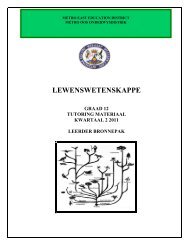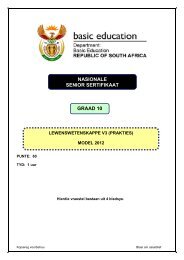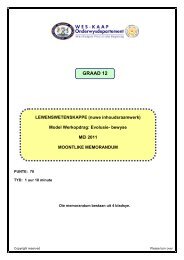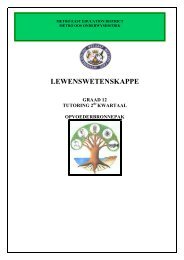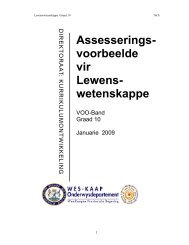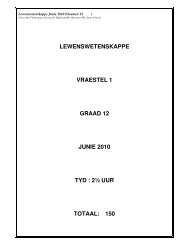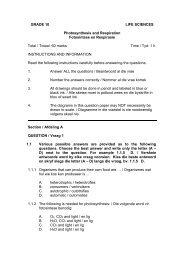40 INSTRUCTIONS AND INFORMATION / Instruksies en Inligting 1 ...
40 INSTRUCTIONS AND INFORMATION / Instruksies en Inligting 1 ...
40 INSTRUCTIONS AND INFORMATION / Instruksies en Inligting 1 ...
Create successful ePaper yourself
Turn your PDF publications into a flip-book with our unique Google optimized e-Paper software.
Plant Tissue/ Plantweefsel Gr 10 Marks / Punte: <strong>40</strong><br />
<strong>INSTRUCTIONS</strong> <strong>AND</strong> <strong>INFORMATION</strong> / <strong>Instruksies</strong> <strong>en</strong> <strong>Inligting</strong><br />
1. Answer ALL the questions / Beantwoord al die vrae<br />
2. Number the answers correctly / Nommer die vrae korrek<br />
3. All drawings should be done in p<strong>en</strong>cil and labeled in blue or black ink / Alle<br />
sketse moet in potlood wees <strong>en</strong> die byskrifte in blou of swart ink<br />
4. The diagrams in this question paper are NOT necessarily drawn to<br />
scale / Die diagramme in die vraestel is nie noodw<strong>en</strong>dig volg<strong>en</strong>s skaal<br />
nie<br />
SECTION / Afdeling A<br />
Question / Vraag 1<br />
1.1 Various possible options are provided as answers to the following questions.<br />
Choose the correct answer and write only the letter (A – D) next to the question<br />
(1.1.1 – 1.1.3). For example 1.1.6 D. / Vier moontlike antwoorde word by elke<br />
vraag verskaf. Kies die beste antwoord <strong>en</strong> skryf die letter (A – D) langs die<br />
vraagnommer (1.1.1 – 1.1.3) bv. 1.1.5. D.<br />
1.1.1 The following is needed for photosynthesis: / Die volg<strong>en</strong>de word vir fotosintese<br />
b<strong>en</strong>odig:<br />
A O2, CO2 and light / <strong>en</strong> lig<br />
B H2O, CO2 and light / <strong>en</strong> lig<br />
C CO2 and light / <strong>en</strong> lig<br />
D H2O and light / <strong>en</strong> lig<br />
1.1.2 The stomata control the supply of the following raw material that is necessary for<br />
photosynthesis / Die huidmondjies beheer die beskikbaarheid van die volg<strong>en</strong>de<br />
grondstof wat vir fotosintese b<strong>en</strong>odig word:<br />
A Enzymes / Ensieme<br />
B Carbon dioxide / Koolstofdioksied<br />
C Oxyg<strong>en</strong> / Suurstof<br />
D Mineral salts / Mineraal soute<br />
1.1.3 The main force causing water to flow from the roots to the leaves is ... / Die hoof<br />
krag wat verantwoordelik is vir die vloei van water van die wortels na die blare is ...<br />
A Root pressure / Worteldruk<br />
B Resspiration/ Respirasie<br />
C Capillarity /Kapillariteit<br />
D Transpiration / Transpirasie (2 x 3)<br />
1.2 Each of the following statem<strong>en</strong>ts can be replaced by a biological term. Write only<br />
the term beside the appropriate number on the answer sheet. / Elke<strong>en</strong> die<br />
volg<strong>en</strong>de stellings kan vervang word met 'n biologiese term. Skry slegs die<br />
term langs die gepaste nommer neer.<br />
[6]
1.2.1 The type of tissue responsible for transporting water. / Die tipe weefsel wat<br />
verantwoordelik is vir die vervoer van water.<br />
1.2.2 Cells that regulate the release of water from a leaf. / Selle wat verantwoordelik is vir<br />
die vrystelling van water by 'n blaar.<br />
1.2.3 The force betwe<strong>en</strong> water molecules. / Die krag tuss<strong>en</strong> water molekule.<br />
(1 x 3)<br />
[3]<br />
1.3 Choose a description from COLUMN B that matches an item in COLUMN A.<br />
Write only the letter (A – G) next to the question number (1.3.1 – 1.3.3), for<br />
example 1.3.6 J. / Kies uit kolom B 'n beskrywing wat die beste pas by die<br />
item in kolom A. Skryf slegs die letter langs die vraagnommer, bv. 1.3.6 J.<br />
Question COLUMN A<br />
Answer<br />
Antwoord COLUMN B<br />
1.3.1 Cuticle / Kutukila A Photosynthesis / Fotosintese<br />
1.3.2 Turgor / Turgor B<br />
1.3.3<br />
Guard cells /<br />
Sluitselle<br />
SECTION / Afdeling B<br />
Question / Vraag 2<br />
C<br />
D<br />
E<br />
Hard and thick<strong>en</strong>ed walls / Harde <strong>en</strong><br />
verdikte wande<br />
Wilting / Verlep<br />
Water proof / Waterdig<br />
Xylem/ Xileem<br />
2. Study the diagram below and answer the questions that follow. / Bestudeer die<br />
volg<strong>en</strong>de diagram <strong>en</strong> beantwoord die vrae wat volg.<br />
3<br />
1<br />
2.1 (a) What type of tissue is found at 3 ? / Watter tipe weefsel word by 3 aangetref?(1)<br />
(b) Can this tissue undergo photosynthesis? / Kan die weefsel fotosinteer? (1)<br />
2<br />
(3)
(c) Explain your answer to 2.1(b) / Verduidelik jou antwoord op 2.1(b) (2)<br />
2.2 What structure is repres<strong>en</strong>ted in the diagram? / Watter struktuur word in die<br />
diagram voorgestel? (1)<br />
2.3 Give the name for structure 1. / Id<strong>en</strong>tifiseer struktuur 1. (1)<br />
2.4 Where does one find the structure/organ (in the diagram) on a plant? / Waar word<br />
die struktuur/orgaan (in die diagram) op 'n plant aangetref? (1)<br />
[7]<br />
Question / Vraag 3<br />
3. Study the following diagrams and th<strong>en</strong> answer the questions that follow. /<br />
Bestudeer die volg<strong>en</strong>de diagramme <strong>en</strong> beantwoord die volg<strong>en</strong>de vrae.<br />
3.1 What is repres<strong>en</strong>ted here in diagram 3? / Wat word hier voorgestel in diagram 3?(2)<br />
3.2.1 What is repres<strong>en</strong>ted by the number 3 in Diagram 3 ? / Wat word voorgestel deur<br />
nommer 3 in Diagram 3 ? (1)<br />
3.2.2 Give 2 functions of structure (number) 3./ Gee 2 funksies van struktuur (nommer) 3.<br />
(2)<br />
3.3 What is structure 2 ? / Wat is struktuur 2 ? (1)<br />
[6]<br />
QUESTION / Vraag 4<br />
1<br />
3<br />
2<br />
Diagram 3<br />
An investigation was conducted to show the effects of increasing light int<strong>en</strong>sity on the rate<br />
of photosynthesis of a plant placed in two differ<strong>en</strong>t conc<strong>en</strong>trations of carbon dioxide. The<br />
results are recorded in the table below. / 'n Ondersoek was gedo<strong>en</strong> om die effek van<br />
to<strong>en</strong>em<strong>en</strong>de ligint<strong>en</strong>siteit op fotosintese tempo van 'n plant in twee verskill<strong>en</strong>de<br />
kons<strong>en</strong>trasies van koolstofdioksied te bepaal.
Light Int<strong>en</strong>sity / Lig<br />
int<strong>en</strong>siteit<br />
(arbitrary units)<br />
(arbitrêre e<strong>en</strong>hede)<br />
Production rate of carbohydrates during<br />
photosynthesis (mg.hour -1 )<br />
Produksie tempo van koolstofdioksied tyd<strong>en</strong>s<br />
fotosintese (mg per uur)<br />
In 0,05% CO2 In 0,15% CO2<br />
1 0,9 1,5<br />
2 1,5 2,3<br />
3 2,0 3,1<br />
4 2,3 3,9<br />
5 2,4 4,3<br />
6 2,4 4,3<br />
7 2,4 4,3<br />
4.1 Construct a line-graph of the production rate of carbohydrates (mg.hour -1 ),<br />
plotting both lines (in 0,05% and 0,15% CO2) on the same set of axes. / Tek<strong>en</strong> 'n<br />
lyngrafiek van die koolstofdioksied produksie tempo (mg per uur). Tek<strong>en</strong> beide lyne<br />
(in 0,05% <strong>en</strong> 0,15%) op dieselfde assestelsel. (7)<br />
4.2 At what light int<strong>en</strong>sity does the plant reach its maximum rate of photosynthesis? /<br />
Te<strong>en</strong> watter ligint<strong>en</strong>siteit bereik die plant sy maksimum fotosintese tempo? (1)<br />
4.3 At what light int<strong>en</strong>sity was the production rate at it’s lowest? / By watter ligint<strong>en</strong>siteit<br />
was die produksie tempo die laagste? (1)<br />
4.4 The rate of carbohydrate production, in both conc<strong>en</strong>trations of CO2 (0,05% and 0,15%)<br />
remained constant at light int<strong>en</strong>sities of 5, 6 and 7 arbitrary units. Suggest ONE<br />
possible explanation for this ph<strong>en</strong>om<strong>en</strong>on. / Die produksie tempo van koolstofdioksied,<br />
in beide CO2 kons<strong>en</strong>trasies bly konstant by ligint<strong>en</strong>siteite van 5, 6 <strong>en</strong> 7 arbritrêre<br />
e<strong>en</strong>hede. Noem e<strong>en</strong> moontlike verklkaring vir die verskynsel. (1)<br />
4.5 What is the advantage to a plant of a higher carbon dioxide conc<strong>en</strong>tration? / Wat is die<br />
voordeel vir die plant van 'n hoër CO2 kons<strong>en</strong>trasie? (1)<br />
Question / Vraag 5<br />
5.1 Root hairs are adapted for their function. Give three adaptations of a root hair<br />
that helps it to absorb water. / Wortelhare is aangepas om hul funksie te kan<br />
verrig. Noem drie aanpassings van 'n wortelhaar wat help vir waterabsorpsie.<br />
(3)<br />
5.2 What do we call the process with which water moves into the root hair? / Wat<br />
word die prose g<strong>en</strong>oem waarmee 'n wortelhaar water opneem. (1)<br />
[4]<br />
Total / Totaal = <strong>40</strong><br />
[11]






